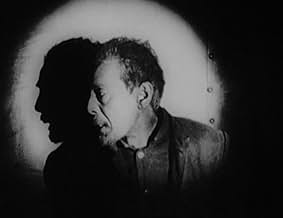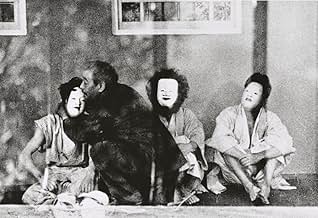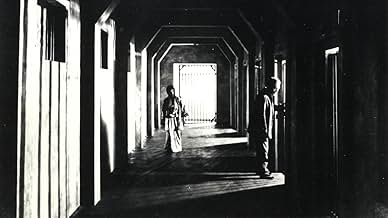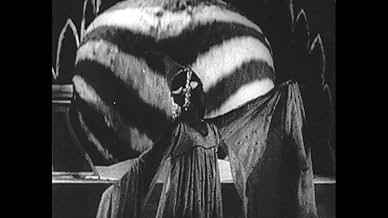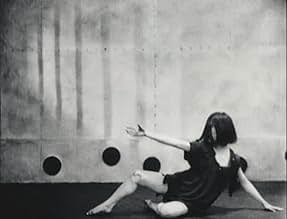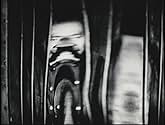Un hombre acepta un trabajo en un manicomio con la esperanza de liberar a su esposa encarcelada.Un hombre acepta un trabajo en un manicomio con la esperanza de liberar a su esposa encarcelada.Un hombre acepta un trabajo en un manicomio con la esperanza de liberar a su esposa encarcelada.
- Dirección
- Guionistas
- Elenco
Opiniones destacadas
Kurutta Ippeji offers a view on the distorted perspective of a troubled janitor in a mental asylum. As a proof of concept, it shows that experimental cinematic techniques can affect the way narration is perceived by the viewer - here, the visual elements contribute to how the viewer experiences the characters' mental state. As an experiment, the movie possibly even makes a stronger case than the comparably surreal Hausu (1977), which is partly imbalanced in its style. However, due to the poor visual quality and the lack of functional storytelling, this experimental feature can't be easily recommended to people looking for a more conventional feature.
Overall 7/10
Full Review on movie-discouse.blogspot.com
If you do not think you can take graphic scenes of mentally unstable people, this film is not for you.This story is about a man who takes a job at a local mental institution so he can be near his wife, who has gone mad. Throughout this long thought lost film you see clearly harrowing images of people at the institution. The soundtrack only adds to the foreboding. There are people lying catatonic and there is a dancer who doesn't stop dancing until she drops to the floor, exhausted. The film is 59 minutes long, I think it was originally longer but this was all that was found. There are no inter titles, its a silent film. In Japan, I am certain the benshi narrated the story in theaters, but your imagination has to follow this story. So, why a 7? It is daring, unflinching, brave and both ugly and not at the same time. As a point of reference only, Guy Maddin's work approaches this. Just know going in there is no happiness here. You won't soon forget this film. Best idea: Don't watch it before bedtime, it will stay with you.
10quinolas
An old man works as a janitor in a mental hospital to be close to his wife who is a patient there and to try to get her out.
This is surely one of the most forgotten masterpieces of the silent era and an oddity in the history of Japanese cinema. Long thought lost, a print was found in the 70s and a music soundtrack added to it, which fits perfectly with the images. It might have been influenced by cabinet of doctor Caligary (director Kinugasa claimed he never saw the German film). However it surpasses it in style and in its more convincing (and chilly) portray of the inner mental state of the inmates in the asylum. To achieve this, the film makes use of every single film technique available at the time: multiple exposures and out of focus subjective point of view, tilted camera angles, fast and slow motion, expressionist lighting and superimpositions among others. It is also a very complicated film to follow, as it has not got intertitles.
The film opens with a montage of shots of rain hitting the windows of the hospital, wind shaking trees and of thunder. The unsettling weather metaphors the mental condition of the patients and introduces one of the them: a former dancer. The combination of sounds produced by rain, wind and thunder serves as the music that incites the dancer to get into a frantic, almost hypnotic dance. In another sequence involving the same patient engaged in another frenzied dance, she is being watched by other inmates. Multiple exposures of the dancer represent the patients' point of view and their confused "view" of the world.
These are just two examples from this amazing film trying to represent the patients' subconscious and view of the "sane" world.
In three words A MUST SEE.
This is surely one of the most forgotten masterpieces of the silent era and an oddity in the history of Japanese cinema. Long thought lost, a print was found in the 70s and a music soundtrack added to it, which fits perfectly with the images. It might have been influenced by cabinet of doctor Caligary (director Kinugasa claimed he never saw the German film). However it surpasses it in style and in its more convincing (and chilly) portray of the inner mental state of the inmates in the asylum. To achieve this, the film makes use of every single film technique available at the time: multiple exposures and out of focus subjective point of view, tilted camera angles, fast and slow motion, expressionist lighting and superimpositions among others. It is also a very complicated film to follow, as it has not got intertitles.
The film opens with a montage of shots of rain hitting the windows of the hospital, wind shaking trees and of thunder. The unsettling weather metaphors the mental condition of the patients and introduces one of the them: a former dancer. The combination of sounds produced by rain, wind and thunder serves as the music that incites the dancer to get into a frantic, almost hypnotic dance. In another sequence involving the same patient engaged in another frenzied dance, she is being watched by other inmates. Multiple exposures of the dancer represent the patients' point of view and their confused "view" of the world.
These are just two examples from this amazing film trying to represent the patients' subconscious and view of the "sane" world.
In three words A MUST SEE.
A Page of Madness is an expressionistic Japanese film that has not gotten the attention it deserves. I was introduced to the film through the fifteen part documentary series The Story of Film an Odyssey. Fortunately, a friend had dubbed the silent film off of Turner Classic Movies during one of its infrequent showings.
The clip in The Story of a Film an Odyssey looked like some mad movie genius had crossed the set designs from a German expressionist film with the fast edits of a classic Russian work. This clip was from the attention grabbing opening of A Page of Madness. A janitor wanders an insane asylum at night during a storm. The storm has a strange effect on the patients and, presumably, the attendant. The edits are fast, conveying mystery and terror like in a horror film. This sequence (and a sequence at the climax) is nothing short of brilliance.
From here the film turns to a narrative, although an oblique one. This clerk or janitor seems to have an unhealthy fixation on one of the female patients. . . and more of one for this patient's daughter. The janitor clearly knew this family before the mother was committed. IMDb says that the woman is the janitor's wife. I am not doubting this, but the film is not clear on this point. What is clear is that the janitor is suffering from a lack of love. This janitor is not the only one. One patient is compelled to dance suggestively and nearly starts a riot. By contrast, the doctors appear clinical and ineffectual. As the film goes along, the protagonist's mental state seems to wane.
Much about the plot is unclear. Many Japanese silent were narrated by a spokesman in the theater. This may have been the case with A Page of Madness; thus, some of the ambiguity would have been explained by the live narrator. I prefer to think the ambiguity was deliberate and never explained. The film has a wonderful sense of mystery to it. I don't want any more of an explanation. I (and probably most film fans) watch a lot of movies that are merely fair. These films are watchable, but they do not stay in one's memory. That is why A Page of Madness is so stunning. It kicks the door down and announces itself to the world. I feel less like a reviewer than a herald for a lost classic. Are you listening Criterion?
The clip in The Story of a Film an Odyssey looked like some mad movie genius had crossed the set designs from a German expressionist film with the fast edits of a classic Russian work. This clip was from the attention grabbing opening of A Page of Madness. A janitor wanders an insane asylum at night during a storm. The storm has a strange effect on the patients and, presumably, the attendant. The edits are fast, conveying mystery and terror like in a horror film. This sequence (and a sequence at the climax) is nothing short of brilliance.
From here the film turns to a narrative, although an oblique one. This clerk or janitor seems to have an unhealthy fixation on one of the female patients. . . and more of one for this patient's daughter. The janitor clearly knew this family before the mother was committed. IMDb says that the woman is the janitor's wife. I am not doubting this, but the film is not clear on this point. What is clear is that the janitor is suffering from a lack of love. This janitor is not the only one. One patient is compelled to dance suggestively and nearly starts a riot. By contrast, the doctors appear clinical and ineffectual. As the film goes along, the protagonist's mental state seems to wane.
Much about the plot is unclear. Many Japanese silent were narrated by a spokesman in the theater. This may have been the case with A Page of Madness; thus, some of the ambiguity would have been explained by the live narrator. I prefer to think the ambiguity was deliberate and never explained. The film has a wonderful sense of mystery to it. I don't want any more of an explanation. I (and probably most film fans) watch a lot of movies that are merely fair. These films are watchable, but they do not stay in one's memory. That is why A Page of Madness is so stunning. It kicks the door down and announces itself to the world. I feel less like a reviewer than a herald for a lost classic. Are you listening Criterion?
I saw the 1 hour version shown on TCM. I'll like to see the 78 minute restoration as this version has no inter titles, no translation of signs and missing a third of the film. Now, back then a benshi would live narrate so there wouldn't be titles but do they have a copy of what the benshi said during the film (if anything)? I would read a synopsis before watching as it makes things clearer. The plot is hard to follow, some of it is from the POV of crazy people or the dream of the protagonist. Well worth watching but more for admiration than enjoyment.
¿Sabías que…?
- TriviaThis film was deemed lost for more than forty years, but it was rediscovered by its director, Teinosuke Kinugasa, in a rice cans in 1971.
- Versiones alternativasReissued in Japan in 1973 with musical score replacing original benshi.
- ConexionesFeatured in La historia del cine: Una odisea: The Golden Age of World Cinema (2011)
Selecciones populares
Inicia sesión para calificar y agrega a la lista de videos para obtener recomendaciones personalizadas
- How long is A Page of Madness?Con tecnología de Alexa
Detalles
- Fecha de lanzamiento
- País de origen
- Idiomas
- También se conoce como
- A Page of Madness
- Locaciones de filmación
- Kioto, Japón(Studio)
- Productoras
- Ver más créditos de la compañía en IMDbPro
Taquilla
- Presupuesto
- JPY 20,000 (estimado)
- Tiempo de ejecución1 hora 10 minutos
- Color
- Mezcla de sonido
- Relación de aspecto
- 1.33 : 1
Contribuir a esta página
Sugiere una edición o agrega el contenido que falta

Principales brechas de datos
What is the German language plot outline for Kurutta ippêji (1926)?
Responda
